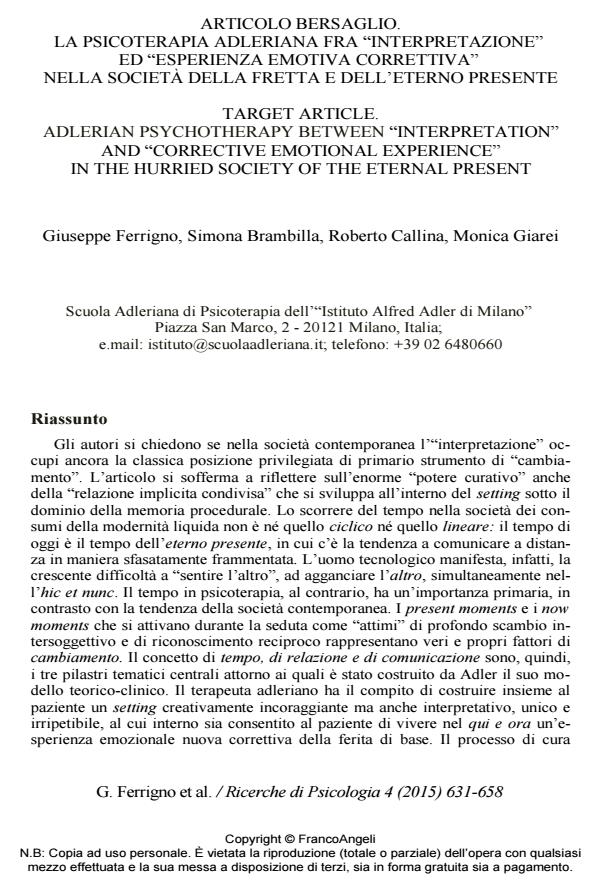Target article. Adlerian psychotherapy between "interpretation" and "corrective emotional experience" in the hurried society of the eternal present
Journal title RICERCHE DI PSICOLOGIA
Author/s Giuseppe Ferrigno, Simona Brambilla, Roberto Callina, Monica Giarei
Publishing Year 2016 Issue 2015/4
Language Italian Pages 28 P. 631-658 File size 136 KB
DOI 10.3280/RIP2015-004003
DOI is like a bar code for intellectual property: to have more infomation
click here
Below, you can see the article first page
If you want to buy this article in PDF format, you can do it, following the instructions to buy download credits

FrancoAngeli is member of Publishers International Linking Association, Inc (PILA), a not-for-profit association which run the CrossRef service enabling links to and from online scholarly content.
The authors wonder if in contemporary society "interpretation" still occupies the privileged position of the classical primary tool of "change". The article reflects on the enormous "healing power" of the "shared implicit relationship" that develops within the setting under the domain of procedural memory. The flow of time in the consumer society of liquid modernity is neither cyclical nor linear: the time today is the time of the eternal present, where there is a tendency to communicate remotely in a shifted fragmentation. The technological man manifests, in fact, the increasing difficulty to "listen to each other", to connect with each other, simultaneously "here and now". The time in psychotherapy, conversely, is primary, in contrast with the trend of contemporary society. The present moments and now moments that are being activated during the session as "moments" of deep inter-exchange and mutual recognition, are real agents of change. The concepts of time, relationship and communication are, therefore, the three central thematic pillars around which Adler’s theoretical and clinical model was built. The Adlerian therapist’s task is to build together with the patient a creatively encouraging setting, but also a unique and interpretative one where the patient is allowed to live the "here-and-now" new corrective emotional experience of the basic wound. The treatment process should make up for the lost intimate dimension of "time", and then communication, relationship, sharing within the setting, in contrast with a fast-paced contemporary society.
Keywords: Time, interpretation, corrective emotional experience, contemporary society.
Giuseppe Ferrigno, Simona Brambilla, Roberto Callina, Monica Giarei, Articolo bersaglio. La psicoterapia adleriana fra "interpretazione" ed "esperienza emotiva correttiva" nella società della fretta e dell’eterno presente in "RICERCHE DI PSICOLOGIA " 4/2015, pp 631-658, DOI: 10.3280/RIP2015-004003